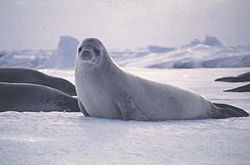| Lobodontine seals [1] Temporal range: Late Miocene to recent | |
|---|---|
 | |
| Crabeater seal, Lobodon carcinophaga | |
| Scientific classification | |
| Kingdom: | Animalia |
| Phylum: | Chordata |
| Class: | Mammalia |
| Order: | Carnivora |
| Parvorder: | Pinnipedia |
| Family: | Phocidae |
| Subfamily: | Monachinae |
| Tribe: | Lobodontini J. E. Gray, 1869 |
| Genera | |
The true seal tribe Lobodontini, collectively known as the Antarctic seals or lobodontin seals, consist of four species of seals in four genera: the crabeater seal (Lobodon carcinophaga), the leopard seal (Hydrurga leptonyx), the Weddell seal (Leptonychotes weddelli), and the Ross seal (Ommatophoca rossii). All lobodontine seals have circumpolar distributions surrounding Antarctica. They include both the world's most abundant seal (the crabeater seal) and the only predominantly mammal-eating seal (the leopard seal). While the Weddell seal prefers the shore-fast ice, the other species live primarily on and around the off-shore pack ice. Thus, though they are collectively the most abundant group of seals in the world, the combination of remote range and inaccessible habitat make them among the least well studied of the world's seals.












